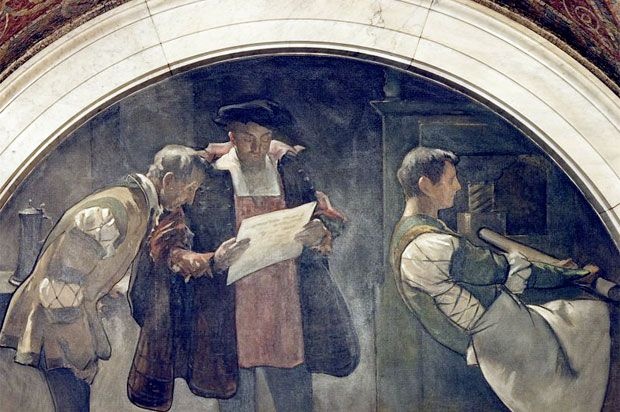1. The Printing Press

Library of Congress
Prior to the rise of the Internet, no innovation did more for the spread and democratization of knowledge than Johannes Gutenberg’s printing press. Developed around 1440 in Mainz, Germany, Gutenberg’s machine improved on already existing presses through the use of a mould that allowed for the rapid production of lead alloy type pieces. This assembly line method of copying books enabled a single printing press to create as many as 3,600 pages per day. By 1500 over 1,000 Gutenberg presses were operating in Europe, and by 1600 they had created over 200 million new books. The printing press not only made books affordable for the lower classes, but it helped spark the Age of Enlightenment and facilitated the spread of new and often controversial ideas. In 1518 followers of the German monk Martin Luther used the printing press to copy and disseminate his seminal work “The Ninety-Five Theses,” which jumpstarted the Protestant Reformation and spurred conflicts like the Thirty Years’ War (1618-48). The printing press proved so influential in prompting revolutions, religious upheaval and scientific thought that Mark Twain would later write, “What the world is today, good and bad, it owes to Gutenberg.”
2. The Compass

DNY59/iStockphoto.com
Magnetic compasses may have been made somewhat obsolete by satellites and global positioning systems, but their impact on early navigation and exploration was inestimable. Originally invented in China, by the 14th century compasses had widely replaced astronomical means as the primary navigational instrument for mariners. The compass provided explorers with a reliable method for traversing the world’s oceans, a breakthrough that ignited the Age of Discovery and won Europe the wealth and power that later fueled the Industrial Revolution. Most importantly, the compass allowed for interaction—both peaceful and otherwise—between previously isolated world cultures.
3. Paper Currency

imagestock/iStockphoto.com
Throughout much of human history, money took the form of precious metals, coins and even raw materials like livestock or vegetables. The inception of paper money ushered in a bold new era—a world in which currency could purchase goods and services despite having no intrinsic value. Paper currency was widely used in China in the ninth century, but did not appear in Europe until the late 1600s. Spurred on by frequent shortages of coins, banks issued paper notes as a promise against future payments of precious metals. By the late 19th century many nations had begun issuing government-backed legal tender that could no longer be converted into gold or silver. The switch to paper money not only bailed out struggling governments during times of crisis—as it did for the United States during the Civil War—but it also ushered in a new era of international monetary regulation that changed the face of global economics. Perhaps even more importantly, paper currency was the vital first step in a new monetary system that led to the birth of credit cards and electronic banking.
4. Steel

josemoraes/iStockphoto.com
While early human societies made extensive use of stone, bronze and iron, it was steel that fueled the Industrial Revolution and built modern cities. Evidence of steel tools dates back 4,000 years, but the alloy was not mass-produced until the invention of the Bessemer Process, a technique for creating steel using molten pig iron, in the 1850s. Steel then exploded into one of the biggest industries on the planet and was used in the creation of everything from bridges and railroads to skyscrapers and engines. It proved particularly influential in North America, where massive iron ore deposits helped the United States become one of the world’s biggest economies.
5. The Electric Light

While they are easy to take for granted, all it takes is a short power outage to remind us of the importance of artificial lights. Pioneered in the early 19th century by Humphry Davy and his carbon arc lamp, electric lights developed throughout the 1800s thanks to the efforts of inventors like Warren de la Rue, Joseph Wilson Swan and Thomas Alva Edison. It was Edison and Swan who patented the first long-lasting light bulbs in 1879 and 1880, liberating society from a near-total reliance on daylight. Electric lights went on to be used in everything from home lighting and street lamps to flashlights and car headlights. The complex networks of wires erected to power early light bulbs also helped lead to the first domestic electrical wiring, paving the way for countless other in-home appliances.
6. Domestication of the Horse

middelveld/iStockphoto.com
Since their domestication some 5,500 years ago, horses have been inextricably tied to human development. They enabled people to travel great distances and gave different cultures the chance to trade and exchange ideas and technology. Equine strength and agility meant that horses could also carry cargo, plow farmland and even clear forests. Perhaps most influential of all, horses changed the nature of war. Nothing was more feared than a horse-drawn chariot or a mounted warrior, and societies that mastered the use of cavalry typically prevailed in battle.
7. Transistors

qingwa/iStockphoto.com
A criminally underappreciated innovation, the transistor is an essential component in nearly every modern electronic gadget. First developed in 1947 by Bell Laboratories, these tiny semiconductor devices allow for precise control of the amount and flow of current through circuit boards. Originally used in radios, transistors have since become an elemental piece of the circuitry in countless electronic devices including televisions, cell phones and computers. The amount of transistors in integrated circuits doubles nearly every two years—a phenomenon known as Moore’s Law—so their remarkable impact on technology will only continue to grow.
8. Magnifying Lenses
 Magnifying lenses might seem like an unremarkable invention, but their use has offered mankind a glimpse of everything from distant stars and galaxies to the minute workings of living cells. Lenses first came into use in the 13th century as an aid for the weak-sighted, and the first microscopes and telescopes followed in the late 16th and early 17th centuries. Figures like Robert Hook and Anton van Leeuwenhoek would go on to use microscopes in the early observance of cells and other particles, while Galileo Galilei and Johannes Kepler employed the telescope to chart Earth’s place in the cosmos. These early uses were the first steps in the development of astonishing devices like the electron microscope and the Hubble Space Telescope. Magnifying lenses have since led to new breakthroughs in an abundance of fields including astronomy, biology, archeology, optometry and surgery.
Magnifying lenses might seem like an unremarkable invention, but their use has offered mankind a glimpse of everything from distant stars and galaxies to the minute workings of living cells. Lenses first came into use in the 13th century as an aid for the weak-sighted, and the first microscopes and telescopes followed in the late 16th and early 17th centuries. Figures like Robert Hook and Anton van Leeuwenhoek would go on to use microscopes in the early observance of cells and other particles, while Galileo Galilei and Johannes Kepler employed the telescope to chart Earth’s place in the cosmos. These early uses were the first steps in the development of astonishing devices like the electron microscope and the Hubble Space Telescope. Magnifying lenses have since led to new breakthroughs in an abundance of fields including astronomy, biology, archeology, optometry and surgery.
9. The Telegraph

SSPL/Getty Images
The telegraph was the first in a long line of communications breakthroughs that later included radio, telephones and email. Pioneered by a variety of inventors in the 18th and 19th centuries, the telegraph used Samuel Morse’s famous Morse code to convey messages by intermittently stopping the flow of electricity along communications wires. Telegraph lines multiplied throughout the 1850s, and by 1902 transoceanic cables encircled the globe. The original telegraph and its wireless successors went on to be the first major advancements in worldwide communication. The ability to send messages rapidly across great distances made an indelible impact on government, trade, banking, industry, warfare and news media, and formed the bedrock of the information age.
10. Antibiotics

SSPL/Getty Images
A giant step forward in the field of medicine, antibiotics saved millions of lives by killing and preventing the growth of harmful bacteria. Scientists like Louis Pasteur and Joseph Lister were the first to recognize and attempt to combat bacteria, but it was Alexander Fleming who made the first leap in antibiotics when he accidentally discovered the bacteria-inhibiting mold known as penicillin in 1928. Antibiotics proved to be a major improvement on antiseptics—which killed human cells along with bacteria—and their use spread rapidly throughout the 20th century. Nowhere was their effect more apparent than on the battlefield: While nearly 20 percent of soldiers who contracted bacterial pneumonia died in World War I, with antibiotics that number dropped to only 1 percent during World War II. Antibiotics like penicillin, vancomycin, cephalosporin and streptomycin have gone on to fight nearly every known form of infection, including influenza, malaria, meningitis, tuberculosis and most sexually transmitted diseases.
11. The Steam Engine

Cars, airplanes, factories, trains, spacecraft—none of these transportation methods would have been possible if not for the early breakthrough of the steam engine. The first practical use of external combustion dates back to 1698, when Thomas Savery developed a steam-powered water pump. Steam engines were then perfected in the late 1700s by James Watt, and went on to fuel one of the most momentous technological leaps in human history during the Industrial Revolution. Throughout the 1800s external combustion allowed for exponential improvement in transportation, agriculture and manufacturing, and also powered the rise of world superpowers like Great Britain and the United States. Most important of all, the steam engine’s basic principle of energy-into-motion set the stage for later innovations like internal combustion engines and jet turbines, which prompted the rise of cars and aircraft during the 20th century.
source: History



